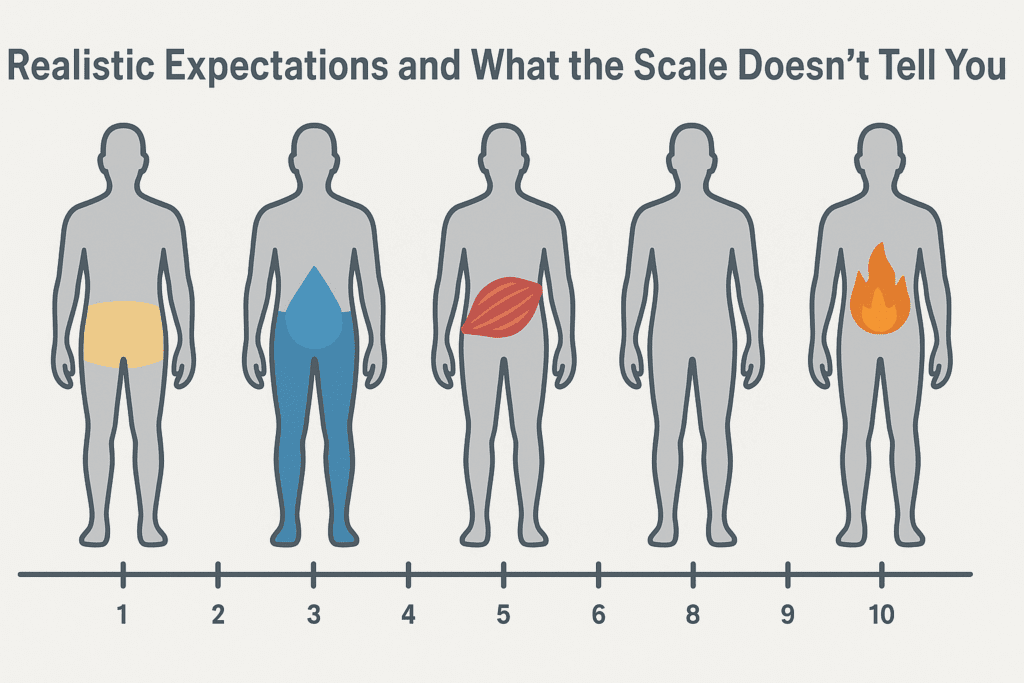Introduction: Rethinking Rapid Results—What “Losing Weight in 10 Days” Really Means
When most people search for how to lose weight in 10 days, what they’re truly looking for isn’t a miracle cure or fad diet—they’re looking for tangible, healthy changes that deliver noticeable results. In a world overflowing with crash diets, detox teas, and unrealistic body expectations, it’s important to approach short-term weight loss with the lens of medical accuracy and practical science. Losing weight quickly can be done safely, but it requires careful planning, metabolic awareness, and a deep understanding of your body’s physiological needs. Contrary to popular belief, weight reduction in this timeframe is not just about slashing calories—it’s about balancing nutrition, hydration, exercise, and mindset.
You may also like: Expert-Backed Weight Loss Tips for a Healthier Lifestyle: What You Need to Know for Long-Term Weight Control and Wellness
This article offers an evidence-based, doctor-recommended guide for those who are seeking to reduce weight in ten days without compromising their health. We’ll explore what the body is capable of achieving over a short period and break down the strategies that work—and those that can backfire. With expert insights and EEAT-aligned health guidance, we’ll also unpack how much weight you can lose in 10 days realistically, what influences that outcome, and how to do it in a way that’s sustainable and safe.

Understanding the Science of Short-Term Weight Loss
The phrase “how much weight can you lose in 10 days” often conjures up grand expectations, but science offers a grounded answer. Most physicians agree that a healthy weight loss pace is approximately 1 to 2 pounds per week. However, in a 10-day period—particularly at the beginning of a new dietary regimen—many individuals experience a sharper initial drop due to water loss, glycogen depletion, and shifts in sodium balance. While the scale may show a loss of 3 to 5 pounds or even more during this time, not all of that weight is fat.
Glycogen, the storage form of carbohydrate in the body, holds water—about three grams for every gram of glycogen. When carbohydrate intake is significantly reduced, glycogen stores are tapped for energy, and water is lost along with them. This can create the illusion of rapid fat loss, but the effect is temporary unless supported by sustainable fat-burning behaviors like regular physical activity and nutrient-balanced eating.
To truly reduce weight in ten days and sustain that loss, individuals must focus not just on the scale, but on body composition changes. Muscle preservation, fat metabolism, and metabolic rate maintenance all contribute to the success of a short-term plan. Rapid weight loss that sacrifices muscle mass can backfire by reducing resting metabolic rate, making it harder to keep the weight off. That’s why medically sound approaches emphasize whole foods, strategic exercise, hydration, and stress regulation.

Dietary Strategies Backed by Medical Experts
One of the first and most impactful ways to begin short-term weight loss is through dietary modification. But unlike starvation diets or extreme cleanses, doctor-recommended plans focus on nutrient density, portion control, and glycemic balance. When people ask how to lose weight in 10 days, what they need isn’t a starvation blueprint—it’s a recalibrated nutritional strategy that supports fat loss while preserving energy and muscle function.
Reducing refined carbohydrates, processed sugars, and sodium can yield fast results—particularly in terms of reduced bloating, lower water retention, and improved insulin sensitivity. Instead of heavily restricting food intake, aim for lean proteins (like chicken, tofu, or eggs), fibrous vegetables (broccoli, spinach, Brussels sprouts), and healthy fats (avocados, olive oil, nuts) that help control hunger hormones like ghrelin and leptin. Eating this way promotes a feeling of satiety and stabilizes blood sugar levels, both essential for reducing weight in ten days without mood swings or fatigue.
Timing also plays a crucial role. Several studies support intermittent fasting windows such as 16:8 (16 hours of fasting, 8-hour eating window) for short-term metabolic efficiency. Although not appropriate for everyone, this approach can promote insulin regulation and help some individuals manage caloric intake naturally. Medical experts caution, however, that any dietary shift should be personalized, and those with underlying health conditions should always consult a healthcare provider before trying intermittent fasting or low-carb programs.

The Role of Hydration in Ten-Day Weight Loss
Water might not seem like a weight loss tool at first glance, but its role in short-term weight regulation is profound. When people start asking how much weight can you lose in 10 days, hydration isn’t usually the first factor that comes to mind—yet it’s often the easiest to address with immediate impact.
Proper hydration aids digestion, supports detoxification through the kidneys and liver, and enhances metabolism. Moreover, dehydration is frequently mistaken for hunger, leading to unnecessary snacking or overeating. A well-hydrated body is better able to oxidize fat, transport nutrients efficiently, and regulate core body temperature during exercise.
Doctors recommend aiming for at least half your body weight in ounces of water per day, increasing that amount if you’re engaging in intense exercise or exposed to heat. To optimize results, avoid sugar-laden beverages, sodas, and even fruit juices, which can add hidden calories and spike insulin levels. Green tea, black coffee (in moderation), and herbal infusions can support fat metabolism while keeping total caloric intake in check.
Drinking water before meals has also been shown to reduce calorie intake by promoting satiety. A study published in the journal Obesity found that adults who drank water before meals consumed fewer calories and lost more weight than those who didn’t. This simple strategy can be particularly helpful when your goal is to reduce weight in ten days while maintaining a sustainable eating pattern.

Physical Activity and Fat Mobilization
No ten-day weight loss plan is complete without physical activity. While it’s tempting to go all-in with cardio bootcamps and endless hours on the treadmill, science suggests that a smarter, more strategic approach yields better results. When thinking about how to reduce weight in ten days, blending resistance training with moderate cardiovascular activity helps preserve lean muscle while increasing fat burn.
Resistance training—using bodyweight, resistance bands, or light weights—stimulates muscle fibers and keeps the metabolism elevated for hours post-exercise. This is critical, as losing muscle mass during rapid weight loss can impair long-term success. Meanwhile, aerobic exercise such as brisk walking, cycling, or swimming increases caloric expenditure and promotes cardiovascular health, which supports overall fat metabolism.
High-intensity interval training (HIIT) can be especially effective for individuals short on time. By alternating short bursts of intense activity with recovery periods, HIIT boosts both aerobic and anaerobic capacity. It also increases the afterburn effect—known as excess post-exercise oxygen consumption (EPOC)—which enhances fat burning long after your workout ends.
It’s important not to overtrain during a short-term weight loss period, as elevated cortisol from excessive stress or insufficient rest can actually hinder fat loss and promote water retention. Balancing exercise with rest, sleep, and recovery ensures that your body has the resources it needs to adapt and thrive during these ten days.

Sleep, Stress, and Hormonal Balance
What often goes overlooked in conversations around how to lose weight in 10 days is the role of sleep and stress management. Yet, sleep quality and chronic stress are among the most powerful determinants of metabolic health. Research has consistently shown that inadequate sleep—less than six hours per night—can lead to hormonal imbalances that increase hunger and reduce satiety. Hormones like ghrelin and leptin become dysregulated, leading to increased cravings, particularly for high-carb and sugary foods.
Cortisol, the body’s primary stress hormone, plays a complex role in weight gain and retention. Elevated cortisol levels due to chronic stress, sleep deprivation, or intense overtraining can cause the body to hold on to fat, particularly in the abdominal region. Moreover, stress increases the likelihood of emotional eating, which can undermine even the most disciplined short-term weight loss plans.
Optimizing sleep hygiene by establishing a consistent bedtime, limiting screen exposure at night, and creating a calm sleep environment can dramatically improve weight regulation outcomes. Similarly, incorporating daily stress reduction techniques such as meditation, breathwork, nature walks, or even journaling can promote hormonal balance and emotional well-being. These lifestyle factors often go unaddressed, but they are essential to safely reduce weight in ten days and sustain those results.

Realistic Expectations and What the Scale Doesn’t Tell You
Understanding how much weight you can lose in 10 days requires more than just watching the number on the scale—it demands an awareness of the bigger picture. The scale reflects total body weight, which includes water, muscle, bone, and fat. Changes in any of these components can influence the number without necessarily indicating fat loss. For instance, inflammation from a workout, fluctuations in sodium, or menstrual cycles can all affect weight readings.
Instead of focusing solely on the scale, consider measuring waist circumference, how your clothes fit, or changes in energy and mood. These indicators often tell a more accurate story of progress. If you’re eating more mindfully, exercising consistently, and sleeping better, you’re likely moving in the right direction—even if the scale fluctuates.
Doctors emphasize that while you can reduce weight in ten days, this period should ideally be seen as a jumpstart—not a finish line. The goal isn’t to return to old habits on day 11, but to use this experience as a foundation for longer-term behavior change. Avoiding fad diets or aggressive restrictions ensures you don’t rebound with weight gain or metabolic slowdown once the 10 days are over.
Medical Considerations and Individualization
Short-term weight loss plans should never adopt a one-size-fits-all approach. Age, gender, hormonal status, medical history, and body composition all influence how the body responds to a rapid weight loss plan. People with metabolic disorders like diabetes, thyroid dysfunction, or PCOS may need tailored strategies and medical supervision. Similarly, those taking certain medications should consult a physician before altering their diet or exercise routine.
Even among healthy individuals, personalization is key. Some people thrive on low-carb, high-protein diets, while others do better with higher fiber and complex carbs. Understanding your own metabolic tendencies, food sensitivities, and emotional triggers around eating can help you build a sustainable framework. Functional nutritionists often use personalized plans based on blood markers, gut health analysis, or genetic insights to guide clients in achieving safe and efficient results.
This principle of individualization ensures that rapid weight loss isn’t just a quick fix but a step toward long-term metabolic resilience. It aligns with the EEAT model by prioritizing expert guidance and medically sound decisions over generic advice or cookie-cutter plans. In this way, learning how to lose weight in 10 days becomes not just about the outcome, but the process of reclaiming control over your health in a safe, informed, and empowering manner.
Frequently Asked Questions (FAQ): Doctor-Recommended Insights on How to Lose Weight in 10 Days Safely
1. Can changing your mindset actually help with how to lose weight in 10 days?
Absolutely. The psychology of weight loss is often underestimated, yet mindset plays a critical role in any short-term success. When you’re focused solely on the outcome—like how much weight can you lose in 10 days—you risk overlooking the process, which includes emotional triggers, eating habits, and self-regulation. Research in behavioral medicine has shown that goal-setting, visualization, and self-monitoring (such as journaling food intake or daily reflections) can enhance both motivation and compliance. By shifting your mindset from deprivation to empowerment, you’re more likely to build a healthy routine that supports how to reduce weight in ten days while laying the groundwork for sustainable behavior beyond that timeframe. This mental framing can improve adherence to dietary changes, help navigate cravings, and reduce the chances of rebound eating after the 10-day period ends.
2. How does gut health affect how much weight you can lose in 10 days?
Emerging research highlights a fascinating link between gut microbiota and weight regulation. The composition of your gut bacteria can influence how efficiently you extract calories from food, regulate hunger hormones like ghrelin and leptin, and modulate inflammation—all of which impact short-term weight loss. If you’re wondering how to lose weight in 10 days but have poor gut diversity due to processed food, antibiotics, or stress, you may be sabotaging your own efforts. Introducing fermented foods like kimchi, kefir, or sauerkraut, along with prebiotic-rich vegetables like leeks and garlic, can quickly shift your gut environment to favor microbes associated with leanness. While this won’t yield massive fat loss overnight, it can meaningfully support how to reduce weight in ten days by improving digestion and nutrient utilization.
3. Is it safe to use weight loss supplements during a 10-day program?
The safety and effectiveness of weight loss supplements vary widely. While some over-the-counter supplements claim to accelerate fat loss, few are backed by rigorous clinical evidence, and many pose risks such as increased heart rate, insomnia, or gastrointestinal distress. When considering how to lose weight in 10 days, it’s important to understand that supplements should not replace a solid nutrition and exercise plan. Instead, doctor-approved supplements like green tea extract or conjugated linoleic acid (CLA) may provide a modest metabolic edge when combined with proper lifestyle changes. However, if you’re focused on how much weight you can lose in 10 days, remember that relying on supplements without professional guidance can compromise safety and is unlikely to produce lasting results.
4. Can social support influence your ability to reduce weight in ten days?
Yes, social and environmental factors have a measurable impact on short-term weight loss success. Studies show that individuals who involve friends, family, or accountability partners in their efforts are more likely to follow through with their goals. Whether you’re participating in a group challenge, working with a coach, or simply sharing progress with a trusted friend, the social feedback loop can enhance motivation and consistency. If you’re trying to determine how much weight you can lose in 10 days, consider how your environment supports or hinders those efforts. Having access to healthy meals, a walking buddy, or someone who can encourage you when cravings strike could make a meaningful difference in how effectively you reduce weight in ten days.
5. What are some overlooked strategies that help with how to reduce weight in ten days?
One often-overlooked strategy is managing meal timing in sync with your circadian rhythm. Research indicates that eating earlier in the day—when insulin sensitivity is higher—supports better blood sugar control and fat metabolism. If you’re exploring how to lose weight in 10 days, shifting most of your caloric intake to breakfast and lunch, while keeping dinner light and early, may enhance your results. Another effective method is incorporating thermogenic foods like chili peppers or ginger, which can slightly increase metabolic rate. Even standing more throughout the day or using a standing desk can contribute to higher energy expenditure. These micro-habits, while subtle, can compound to support how much weight you can lose in 10 days without requiring drastic lifestyle overhauls.
6. Are there specific conditions where short-term weight loss should be avoided?
Yes, individuals with certain medical conditions should avoid aggressive short-term weight loss unless supervised by a healthcare provider. People with Type 1 diabetes, severe heart disease, eating disorders, or recent surgical recovery may experience complications if they drastically alter caloric intake or exercise routines. Even if you’re eager to discover how much weight you can lose in 10 days, it’s essential to prioritize safety. In these cases, a doctor may recommend a slower, more controlled approach to avoid triggering metabolic disturbances or exacerbating existing health issues. If you’re uncertain about how to reduce weight in ten days with a medical condition, a registered dietitian or physician should guide you through a customized plan.
7. How does muscle retention influence short-term weight loss outcomes?
When evaluating how to lose weight in 10 days, many people overlook the importance of preserving lean muscle mass. Muscle tissue is metabolically active, meaning it burns more calories at rest than fat does. Crash diets that eliminate protein or over-rely on cardio can lead to muscle catabolism, ultimately lowering your basal metabolic rate and undermining future fat loss efforts. To optimize how much weight you can lose in 10 days while protecting muscle, incorporate resistance training and consume adequate protein—generally 1.2 to 2.0 grams per kilogram of body weight per day, depending on activity level. Maintaining muscle mass not only enhances body composition but also supports better energy levels and functional strength.
8. What role do hormones play in determining how much weight you can lose in 10 days?
Hormonal fluctuations can significantly influence your short-term weight loss potential. Insulin, cortisol, thyroid hormones, and sex hormones like estrogen and testosterone all contribute to how the body stores and burns fat. For example, elevated insulin levels from frequent snacking or high-carb meals can impair fat oxidation, making it harder to reduce weight in ten days. Likewise, chronic stress raises cortisol, which may lead to increased abdominal fat and water retention. Those asking how to lose weight in 10 days should consider their hormonal landscape—especially if weight loss has historically been challenging despite caloric restriction. In some cases, functional lab testing may reveal imbalances that need to be addressed before meaningful progress can occur.
9. Can traveling or working irregular hours interfere with short-term weight loss goals?
Travel and shift work can indeed disrupt your body’s metabolic rhythm, making it harder to reduce weight in ten days. Jet lag, inconsistent meal times, and lack of access to healthy food can throw off hormonal patterns, digestive function, and even sleep quality. If you’re serious about how to lose weight in 10 days while navigating a non-routine lifestyle, pre-planning is essential. Pack portion-controlled snacks, stay hydrated, and anchor your schedule with consistent wake-sleep cycles whenever possible. Even small wins—like walking in an airport terminal instead of using a people mover—can help maintain momentum. Flexibility and foresight are key to sustaining weight loss behaviors in unpredictable environments.
10. What should I do after the 10 days to maintain progress and avoid rebound weight gain?
The ten-day period should ideally serve as a launching pad rather than a temporary fix. Once you’ve achieved your initial goal, it’s critical to shift from restrictive behaviors to sustainable habits. Many who ask how to reduce weight in ten days risk regaining that weight quickly if they return to previous patterns. Transitioning to a moderate, long-term eating strategy—such as the Mediterranean or DASH diet—can stabilize your progress. Continue monitoring your habits, setting new goals, and adjusting your exercise regimen to maintain variety and motivation. Ultimately, understanding how much weight you can lose in 10 days becomes more valuable when it’s paired with a strategy for maintaining those results through consistency, flexibility, and self-awareness.
Conclusion: Short-Term Progress, Long-Term Impact—What You Need to Know About Losing Weight in 10 Days Safely
The question of how much weight you can lose in 10 days is more than a numbers game—it’s a gateway into understanding your body’s physiology, nutrition needs, and behavioral patterns. When approached with the right mindset and supported by science-backed strategies, short-term weight loss can be both safe and transformative. But it must be rooted in trust, logic, and expert-backed wellness principles.
By focusing on nutrient-rich foods, strategic hydration, balanced exercise, and restorative sleep, individuals can safely reduce weight in ten days while building habits that extend beyond this window. The most effective short-term programs are those that respect the body’s complexity, honor individual needs, and avoid the pitfalls of quick-fix marketing. Instead of chasing unrealistic outcomes, this approach encourages progress that is both tangible and sustainable.
Ultimately, knowing how to lose weight in 10 days isn’t about finding a shortcut—it’s about developing a deeper relationship with your health. It’s about embracing small, strategic shifts that compound over time, allowing you to look, feel, and function better in the long run. With the right guidance, every 10-day period can be the beginning of a lifelong commitment to well-being.


